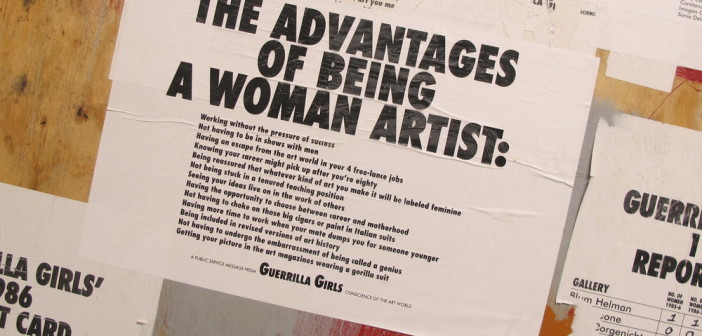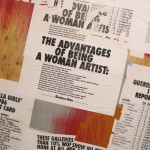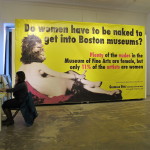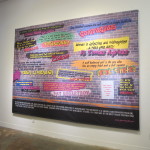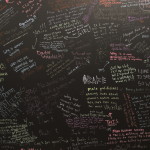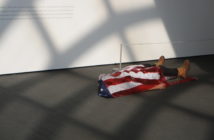This time last week, I sat in a pew at Montserrat's second annual academic symposium, Agents of Change: Art as Activism. It's difficult to imagine a more New England venue for staging a day-long event on engaged art than a white clapboard Congregational church in Beverly, Massachusetts. A Puritan work ethic was present in the event's hours too: beginning at 8.30 in the morning they continued relentlessly, across two locations, until the Guerrilla Girls keynote, ending at 10pm. I'm sorry to say my stamina wasn't up to the task and I bowed out at six, following a number of insightful, at times absorbing, presentations. I was also assured by organizers Leonie Bradbury, Director & Curator of the Galleries, and Maggie Cavallo, Assistant Curator of Education, that the Girls' talk would be available online as a video, soon.
Last year, the keynote was delivered by Robert Storr, Dean of Yale's School of Art and former MoMA curator, to conclude For the Record, a conference organized within the context of the eponymous exhibition For the Record: Searching for Objectivity in Global Conflict. Similarly this year, most of Montserrat's exhibition spaces (301, Frame 301, the main gallery and corridors) were occupied by the Guerrilla Girls' loud banners, educational materials and publications, picketing signs and interactive artworks. Given the amplitude and relevance of the symposium and the art-star keynote speakers, I was astonished not to see better attendance. I'd attribute this to a number of factors: distance from the city and difficulty of access, choosing to hold it on a weekday, and the cost of attending. $75.00 is prohibitive - lunch, dinner and transportation not included. Workshops the next day ranged from an additional $100 to $150 for the privilege of working with the Guerrilla Girls themselves. It is so rare for good opportunities for exchange and networking to present themselves to Boston-area artists, I also wondered why everyone wasn't invited to lunch and dine together, in the spirit of cooperation and engagement. A brown bag would have sufficed.
I shared my frustrations with Maggie Cavallo who admitted Montserrat is still trying to find a successful model - last year's symposium was free of charge - and build a public beyond the College's faculty and students.
 Guerrilla Mobile Billboards at the MFA
Guerrilla Mobile Billboards at the MFA
Copyright © 2012 Anthony Palocci Jr.
The Girls were the axis on which the symposium revolved: all of the presenting artists and academics have a foothold in activism and turned out to be, by a large majority, women. The day began with presentations and a panel talk between artists Liz Glynn, Julia Sherman and Hana van der Kolk, moderated by Randi Hopkins.
Glynn and Sherman were some of the day's stand-outs for me. Both artists excelled at presenting, showed compelling work and gave sharply informed and thoughtful contributions to the discussion. Liz Glynn, a Boston native now ensconced in LA, has shown work locally at Anthony Greaney Gallery.
 Liz Glynn, III, Los Angeles, 2010
Liz Glynn, III, Los Angeles, 2010
Julia Sherman 's multi-faceted project The Habit explores the "stance of radical Nuns in the 60s [...] to modify the habit and assert their independence from the Pope." She also presented her current research-based work on the 1968 Miss America Pageant when the Women’s Liberation movement hung a banner protesting the event. Her own efforts to consider the contemporary state of the American feminist movement lead her to create her own banners, based on historical protest statements, which she absurdly inserts into the backgrounds of live on-street talk-show events.
In the next session on the Occupy movement in particular, Kate Farrington delivered a paper on The Failure of Aesthetics in the Occupy Movement (analyzed through the lens of the 7th Berlin Biennale). While the delivery was a little halting and sleepy, the content was perfect for the context. The Biennale broke the mold by turning its press conference over to activists, who held it in the round, asking the crowd to use hand movements to request the floor and inviting journalists to speak first. Following the overwhelmingly negative response to the Biennale - "a disaster", a "spectacular failure", "not much to see" - Farrington asked herself what importance aesthetics have to activist art. She proposed that the whole event became an art project by its curator, perhaps unsurprisingly since the Berlin Biennale was curated by artist Artur Żmijewski. In and of itself it was a vehicle for revealing deep social problems. Unfortunately, Farrington didn't have sufficient time to read the whole paper - I'd love to get my hands on it and follow her thoughts through to their conclusion.
For the third session, I chose to attend presentations on War, Politics and Healing, particularly for Dr. Deborah Saleeby-Mulligan's talk on mural painting in West Belfast. Peppered with photographs of rivaling Loyalist and Republican murals, it examined the history and ongoing politics surrounding these popular, site-specific and site-reflexive creations. Most interesting perhaps are the contemporary controversies surrounding the murals: amnesia is being forced through governmental support for white-washing the more partisan examples, deemed divisive, and replacing them with "neutral", unifying scenes. The Re-imaging Communities Program, funded by a £6 million grant from the Arts Council of Northern Ireland, is deemed by one famed muralist "as political as the murals that have been removed. It feels like they are killing us with kindness."
At the conclusion of my day, a train ride home with performance artist and curator Sandrine Schaefer was just what I needed. We'd both attended the Creative Time summit in New York City the previous weekend and eagerly compared the two events and the current visibility of activist projects in art. It seems like such a shame for Creative Time to be so well attended when we have a pretty solid model dawning next door.
---
Update: We've just amended to post to note that Liz Glynn has shown with Anthony Greaney in the past.
- Guerrilla Mobile Billboards at the MFA Copyright © 2012 Anthony Palocci Jr.
- Liz Glynn, The 24 hour Rome Reconstruction Project (you can’t build Rome in a day) New Museum, NYC
- Liz Glynn, III, Los Angeles, 2010
"Not Ready to Make Nice: Guerrilla Girls in the Art World and Beyond" is a traveling exhibition, curated by Neysa Page Lieberman from Columbia College Chicago, and is on view until December 15, 2012 at the Montserrat College of Art Gallery in Beverly, MA.
Keep up with the Girls via the Guerrilla Girls website, Twitter Feed and Facebook Page.

